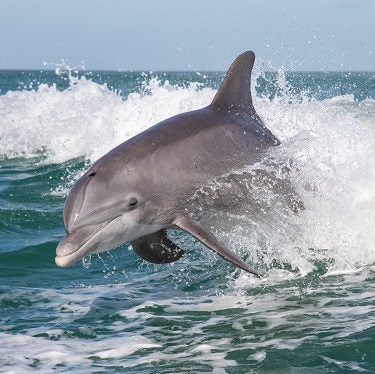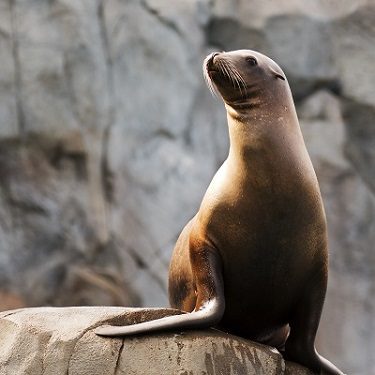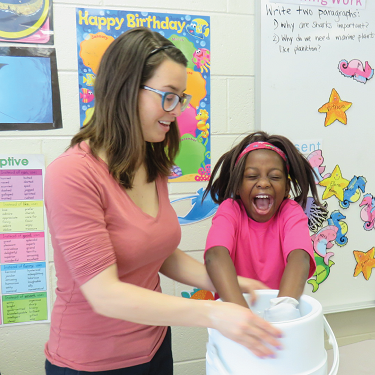Marine Life Encyclopedia
Seabirds
Royal Penguin
Eudyptes schlegeli
Distribution
Macquarie Island, Bishop and Clerk Islands, Australia
eCOSYSTEM/HABITAT
Feed in ocean; breed, mate and rest on rocky beaches
FEEDING HABITS
Foraging Predator
TAXONOMY
Order Sphenisciformes, Family Spheniscidae
Royal penguins nest in large colonies on Macquarie Island and nearby Bishop and Clerk Islands in Australia. They favor rocky or pebbly beaches during most of the year. They are members of the crested penguin family, but unlike other crested penguins that have black chins, royal penguins’ chins and faces are pale grey or white leading up to their colorful plumes. Fitted with black crowns and short orange bills, these penguins are also the tallest of crested penguins, standing at about 28 inches tall. Females are often slightly smaller than the males. Royal penguins feed primarily on krill, along with other small crustaceans, fish or cephalopods, and may fall prey to fur seals or southern elephant seals.
Breeding season for royal penguins last from September to February and usually begins with the males creating small hollows or nests from nearby vegetation and rocks. Once the females arrive to the colony, the royal penguins form monogamous breeding pairs and lay two eggs. One of the eggs, typically the smallest of the two, is pushed away from the nest and the other is incubated by both parents. About 40 days later, the chick hatches and is looked after by the father while the mother forages for food. Eventually, the chick will join other newly hatched penguins in small groups known as crèches. Once the chick has reached 70 days old, it can begin to forage and protect itself.
Royal penguins were heavily exploited in the 19th century but have since recovered. Today, populations are considered stable, but since potential threats like plastic pollution and overfishing are prevalent in their habitat, royal penguins are listed as Near Threatened by the IUCN Red List. Long-term effects of climate change may also severely impact these penguins’ food supply throughout their range.
Fun Facts About Royal Penguins
1. Royal penguins are endemic to Macquarie Island and nearby islets.
2. Royal penguins leave Macquarie after the breeding season, and researchers are unsure where these penguins go during this six-month period before returning.
3. Royal penguins lay two eggs but discard the first egg for an unknown reason.
4. Royal penguins incubate their eggs for 30 days.
5. Male royal penguins guard their chicks for 3 to 4 weeks until they’re large enough to join other chicks.
6. Royal penguins weigh 9 to 14 pounds (4.2 to 6.3 kg) on average, but fatten up right before molting, reaching weights up to 17.6 pounds (8 kg).
7. Royal penguins are named for the bright yellow plumes on their heads that resemble crowns. The older the penguin, the lusher the plumes.1
Engage Youth with Sailors for the Sea
Oceana joined forces with Sailors for the Sea, an ocean conservation organization dedicated to educating and engaging the world’s boating community. Sailors for the Sea developed the KELP (Kids Environmental Lesson Plans) program to create the next generation of ocean stewards. Click here or below to download hands-on marine science activities for kids.
References:
1 Australian Government Department of the Environment and Energy
Get Involved

Donate Today
SUPPORT OUR WORK TO PROTECT THE OCEANS BY GIVING TODAY
With the support of more than 1 million activists like you, we have already protected nearly 4 million square miles of ocean.

TAKE ACTION NOW
Support policy change for the oceans
Decision-makers need to hear from ocean lovers like you. Make your voice heard!

VISIT OUR ADOPTION CENTER
SYMBOLICALLY ADOPT AN ANIMAL TODAY
Visit our online store to see all the ocean animals you can symbolically adopt, either for yourself or as a gift for someone else.

DOWNLOAD OCEAN ACTIVITIES
HELP KIDS DISCOVER OUR BLUE PLANET
Our free KELP (Kids Environmental Lesson Plans) empower children to learn about and protect our oceans!




